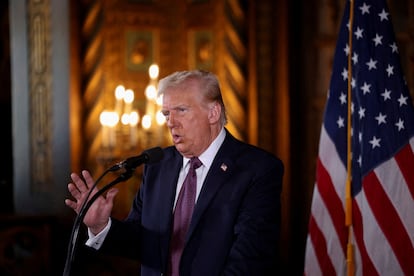Trump opens tariff war against Mexico, Canada and China
The president signed the executive order imposing tariffs of 25% on its neighbors and 10% on the Asian giant, marking the beginning of a trade war


While the world was awaiting one of his most far-reaching decisions since returning to office, U.S. President Donald Trump went to spend Saturday morning at his West Palm Beach (Florida) golf club. The White House announced on Friday the imposition of tariffs of 25% on imports from Mexico and Canada and 10% on imports from China as of this Saturday, but the president had not approved them and the day’s presidential schedule was blank. Goods continued to move freely and uncertainty about the specific content of the measures remained an unknown. Finally, Trump has signed an executive order imposing those tariffs, although the full details are not yet known. The order authorizes Trump to raise the tariffs if there is a response from the affected countries, as expected.
The tariffs are 10% for Canadian energy products. It is not yet clear when they will come into effect, but Canadian government sources quoted by Canadian media have indicated that, at least in their case, it will be on Tuesday.
Trump declares a national emergency to invoke the International Emergency Economic Powers Act (IEEPA), which unilaterally authorizes a president to manage imports during a crisis. The argument cited in the executive order is the influx of fentanyl and undocumented immigrants.
“Today, I have implemented a 25% Tariff on Imports from Mexico and Canada (10% on Canadian Energy), and a 10% additional Tariff on China,”, Trump wrote on Truth Social. “This was done through the International Emergency Economic Powers Act (IEEPA) because of the major threat of illegal aliens and deadly drugs killing our Citizens, including fentanyl. We need to protect Americans, and it is my duty as President to ensure the safety of all. I made a promise on my campaign to stop the flood of illegal aliens and drugs from pouring across our Borders, and Americans overwhelmingly voted in favor of it”, he added.
The magnitude of the tariffs that Trump has approved could have serious repercussions on certain industries, such as the automotive and energy sectors. From January to November 2024, the United States imported $466.6 billion worth of goods from Mexico, purchased $337.2 billion worth of merchandise from Canada, and imported $401.4 billion worth of goods from China. The largest trade deficit in that timeframe was with China, amounting to $270.4 billion, followed by Mexico ($157.2 billion) and Canada ($55 billion), although Trump has repeatedly exaggerated those figures and falsely presented them as subsidies.
On the campaign trail, Trump said he would impose 60% tariffs on all products from China, but in the end the tariffs applied to imports from its biggest geostrategic rival are lower than those of the two neighbors. Tesla chief Elon Musk and other Trump allies have strong economic interests in China.
The tariffs could have dramatic economic consequences and trigger a trade war in North America by infringing on protections in the three-country free trade agreement, the U.S.-Mexico-Canada Agreement (TMEC). Both Canada and Mexico have threatened to respond with possible retaliatory tariffs, although they will have to examine the automatic response mechanism included by Trump in his order.
“No one, on either side of the border, wants to see American tariffs on Canadian goods,” Canada’s Prime Minister Justin Trudeau said Friday. “I met with our Canada-U.S. Council today. We’re working hard to prevent these tariffs, but if the United States moves ahead, Canada’s ready with a forceful and immediate response,” he added. For her part, Mexico’s president Claudia Sheinbaum assured that her country had prepared “a plan A, a plan B and a plan C” to respond to Trump depending on the content of his measures.
Tariffs threaten to plunge Canada and Mexico into recession, although the southern country can remain competitive even with such a price premium, especially with the depreciation of the peso. They may also hurt U.S. growth, create distortions in the supply and production chain in key sectors, such as automobiles, and put upward pressure on prices. The latter could lead the Federal Reserve to keep interest rates higher for longer, as the International Monetary Fund (IMF) recently warned.
“It would be nice if Donald Trump could start focusing on getting the prices down instead of making them go up”, said Senate Democratic Minority Leader, Charles Schumer. “All tariffs are not created equal. Donald Trump is aiming his new tariffs at Mexico, Canada, and China but they will likely hit Americans in their wallets. I am concerned these new tariffs will further drive up costs for American consumers. We should be focused on going hard against competitors who rig the game, like China, rather than attacking our allies. If these tariffs go into full effect, they will raise prices for everything from groceries, to cars, to gas, making it even harder for middle-class families to just get by”, he added.
Saturday’s decision had been in the making for some time. The Republican first threatened 25% tariffs on Mexico and Canada, his two neighbors and main trading partners, last November, when he was president-elect. He said then that he would approve them on his first day in office. Mexico’s President Claudia Sheinbaum spoke with Trump by phone and Canada’s Prime Minister Justin Trudeau traveled to the Mar-a-Lago mansion in Florida to meet with him. Despite good words about those talks, after taking office as president on January 20, Trump moved his threat to February 1. Mexico and Canada have tried to tighten control of their borders to dissuade the U.S. president from imposing the tariffs, but to no avail.
In addition to punishing Mexico and Canada with levies on their products, Trump is pursuing the idea of a general tariff on all imports. He has also promised sectoral tariffs on products such as pharmaceuticals, semiconductor chips, steel, aluminum and copper, which could apply broadly to many countries, including Canada and Mexico.
Among the targets of U.S. tariffs will be the European Union, Trump flatly stated Friday. “Am I going to impose tariffs on the European Union? Do you want the truthful answer, or should I give you a political answer? Absolutely, absolutely,” he told reporters in the Oval Office. The European Union has treated us so terribly,” he said Friday at the White House. “They don’t take our cars, they don’t take our farm products, essentially, they take almost anything. And we have a tremendous deficit with the European Union. So we will do something very substantial with the European Union. We will bring the level up to where it should be,” he added.
Trump’s protectionist policies threaten to unleash a full-scale trade war on the world.
Tu suscripción se está usando en otro dispositivo
¿Quieres añadir otro usuario a tu suscripción?
Si continúas leyendo en este dispositivo, no se podrá leer en el otro.
FlechaTu suscripción se está usando en otro dispositivo y solo puedes acceder a EL PAÍS desde un dispositivo a la vez.
Si quieres compartir tu cuenta, cambia tu suscripción a la modalidad Premium, así podrás añadir otro usuario. Cada uno accederá con su propia cuenta de email, lo que os permitirá personalizar vuestra experiencia en EL PAÍS.
¿Tienes una suscripción de empresa? Accede aquí para contratar más cuentas.
En el caso de no saber quién está usando tu cuenta, te recomendamos cambiar tu contraseña aquí.
Si decides continuar compartiendo tu cuenta, este mensaje se mostrará en tu dispositivo y en el de la otra persona que está usando tu cuenta de forma indefinida, afectando a tu experiencia de lectura. Puedes consultar aquí los términos y condiciones de la suscripción digital.










































